The Common Warts Market is estimated to be valued at USD 826.4 million in 2025 and is projected to reach USD 1177.1 million by 2035, registering a compound annual growth rate (CAGR) of 3.6% over the forecast period.
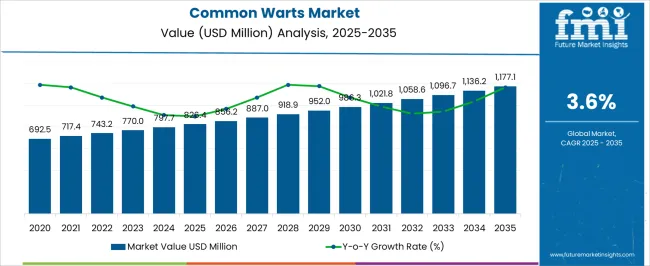
| Metric | Value |
|---|---|
| Common Warts Market Estimated Value in (2025 E) | USD 826.4 million |
| Common Warts Market Forecast Value in (2035 F) | USD 1177.1 million |
| Forecast CAGR (2025 to 2035) | 3.6% |
The common warts market is witnessing consistent growth driven by increasing prevalence of human papillomavirus infections and rising awareness about effective diagnosis and treatment options. The demand for precise diagnostic procedures and efficient therapeutic interventions is shaping market dynamics, supported by advancements in dermatological practices and growing healthcare infrastructure globally.
The shift towards minimally invasive and patient-friendly treatments has been catalyzing adoption of topical medications. Additionally, public health initiatives emphasizing early detection and treatment are enhancing patient outcomes and driving market expansion.
Continued innovation in drug formulations and improved access to dermatological care are expected to sustain growth. The focus on combining efficacy with safety is paving the way for wider acceptance of various treatment modalities, establishing a solid foundation for future market opportunities.
The market is segmented by Diagnosis Procedure, Drug Type, and Medication Class and region. By Diagnosis Procedure, the market is divided into Biopsy and Excision. In terms of Drug Type, the market is classified into Salicylic Acid, Imiquimod, Silver Nitrate, Glutaraldehyde, Formaldehyde, and Aminolevulinic Acid. Based on Medication Class, the market is segmented into Topical Retinoids and Oral Retinoids. Regionally, the market is classified into North America, Latin America, Western Europe, Eastern Europe, Balkan & Baltic Countries, Russia & Belarus, Central Asia, East Asia, South Asia & Pacific, and the Middle East & Africa.
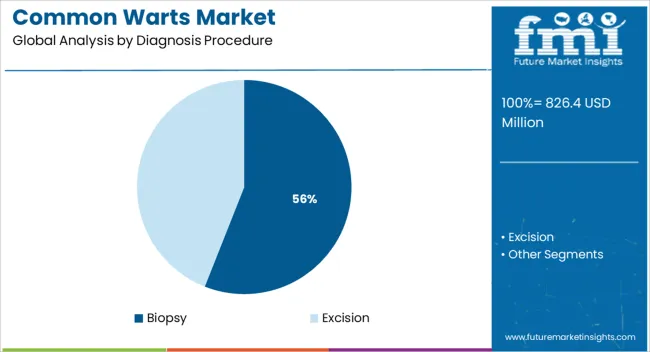
When segmented by diagnosis procedure the biopsy segment is anticipated to hold 56.0% of the total market revenue in 2025 making it the leading diagnostic method. This dominance is attributed to its accuracy in confirming the presence of common warts and ruling out malignancies or other skin conditions. Biopsy’s role in providing definitive pathological insights has been instrumental in guiding targeted treatment decisions.
The preference for biopsy has been reinforced by clinical protocols emphasizing confirmatory diagnostics to minimize misdiagnosis. Additionally biopsy facilitates personalized patient care by enabling dermatologists to assess lesion severity and progression precisely.
Operational adoption is further supported by technological improvements in biopsy techniques which have enhanced safety and patient comfort thereby encouraging widespread clinical use. These factors collectively have driven biopsy to maintain its leadership in diagnostic procedures.
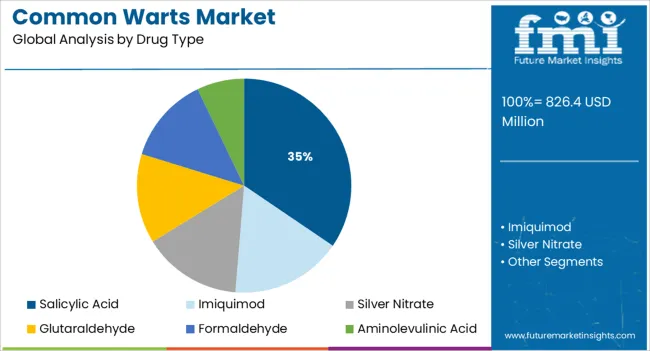
Segmenting by drug type salicylic acid is projected to account for 34.5% of the market revenue share in 2025 establishing itself as the leading therapeutic agent. Its prominence is explained by its proven efficacy as a keratolytic agent that effectively softens and removes wart tissue with minimal side effects.
The accessibility and affordability of salicylic acid formulations have expanded patient adherence and physician preference. Furthermore the topical application modality allows for ease of use in outpatient settings and self-administration which has significantly boosted its market penetration.
Clinical endorsements and inclusion in treatment guidelines have reinforced its position as a first line therapy. Continued formulation improvements aimed at enhancing skin tolerance and treatment duration have also contributed to sustaining growth of the salicylic acid segment.
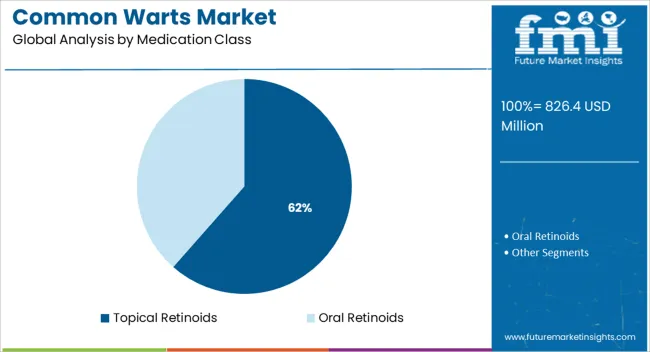
When segmented by medication class topical retinoids are forecast to hold 61.5% share of the market revenue in 2025 positioning them as the leading class of medication. Their leadership stems from the ability to modulate keratinocyte differentiation and proliferation thereby accelerating wart resolution.
The versatility of topical retinoids across different patient demographics and wart types has expanded their clinical use. Adoption has been supported by robust safety profiles and compatibility with combination therapies enhancing overall treatment efficacy.
Increased dermatological research and positive clinical outcomes have driven confidence among healthcare providers in prescribing topical retinoids. Ongoing developments aimed at improving formulation stability and reducing irritation potential are further solidifying this class’s dominance in common wart management.
The global demand for common warts is projected to increase at a CAGR of 3.6% during the forecast period between 2025 and 2035, reaching a total of USD 1,100 Million in 2035, according to a report from Future Market Insights (FMI). From 2020 to 2025, sales witnessed significant growth, registering a CAGR of 2%.
The recurrence rate of genital warts treated with topical podophyllotoxin therapy ranges between 6% and 100%. According to the Centers for Disease Control and Prevention (CDC), anogenital warts often reoccur within three months. Thus, when the recurrence incidence of warts increases, so does the use of goods and therapy, driving the market for common warts.
HPV viruses promote excessive and fast development of keratin, a hard protein found on the skin's top layer. According to the Anal Cancer Foundation, an estimated 14 million people in the USA are infected with HPV each year. According to the Centers for Disease Control and Prevention (CDC), genital warts caused by HPV afflict around 340,000 to 360,000 women and men in the USA each year. As a result, an increase in the prevalence of warts and HPV infections supports the expansion of the common warts market.
The Increasing Prevalence of Common Warts and HPV infections is propelling Market Growth
People with weaker immune systems as a result of organ transplants, major illnesses such as cancer or AIDS, and atopic disorders are more likely to get warts. As a result, an increase in the number of cancer patients raises the prevalence of warts, driving the common warts market.
An increase in the number of HPV infections increases the danger of warts and, as a result, the market. According to the Anal Cancer Foundation, an estimated 14 million people in the USA are infected with HPV each year. According to the Centers for Disease Control and Prevention, genital warts caused by HPV afflict around 340,000 to 360,000 women and men in the USA each year, and they normally appear 2 to 3 months after HPV infection.
There are several treatments available for warts, but recurrences are common. A large majority of instances of genital warts do not respond to therapy and frequently reoccur, especially when infections from HPV have a protracted incubation period. As a result, an increase in the recurrence rate of common warts increases the need for products and therapy. This, in turn, is projected to fuel the market for common warts.
The Common Warts Market is being Hampered by a Low Diagnostic Rate due to a Lack of Awareness
The expansion of the worldwide common warts market is anticipated to be impeded by a lack of knowledge of the diagnosis, which results in fewer reported instances and, as a result, less relevance for treatment choices. Although the frequency of warts is increased, the diagnostic rate in patients is low.
For example, according to the 2020 Health Protection Report, the prevalence of genital warts diagnosis among girls aged 15 to 17 in England accessing sexual health services reduced by 92% compared to 2014.
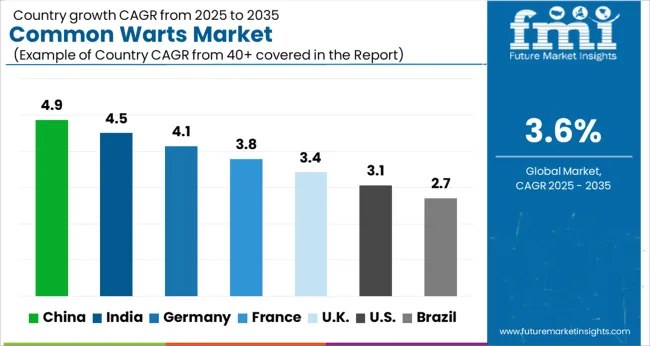
Government Support to Raise Awareness about Sexually Transmitted Diseases Widening Profit Margins
Over the projection period, Asia Pacific is predicted to have high revenue CAGR. There is a significant growth in the elderly population in nations such as China, India, and others.
The region's development rate will be enhanced due to the presence of generic producers and the expansion of healthcare facilities. These important drivers are projected to fuel market revenue growth throughout the forecast period.
Government support to raise awareness about sexually transmitted diseases, an increase in demand for advanced therapeutics, an increase in the prevalence of HPV infections, a rising economy, and a shift in sexual lifestyles in the area are key drivers of the Asia Pacific common warts market. As per Future Market Insights, the Asia Pacific is expected to grow at a CAGR of 3% in the assessment period 2025 to 2035.
Increase in Pharmaceutical Firms' Research and Development Efforts to Accelerate Market Growth
The development of the North American market is attributable to an increase in pharmaceutical firms' Research and Development efforts, a high rate of treatment acceptance in healthcare facilities, and a rise in knowledge about the impacts of common warts. North America is expected to grow at a CAGR of 3.5% in the assessment period 2025 to 2035.
Because of Its Low Cost, Salicylic Acid Improves Clinical Outcomes
There is a growing desire for common warts therapy that leaves no scars and gives lifetime protection against HPV. As a result, businesses in the common warts market are focusing more on tissue keratolysis in order to improve patient results.
Tissue keratolysis, which uses salicylic acid, is popular in over-the-counter (OTC) drugs. This is clear since salicylic acid, a chemical destruction therapy option, is predicted to increase at an exponential rate in the common warts market throughout the projection period.
Key players in the common warts market are Nielsen BioSciences, Verrica Pharmaceutical, Aclaris Therapeutics, Inc., KinoPharma, Inc., pHion Therapeutics, Orgenesis, Novan, Cassiopeia Pharmaceuticals, Innovax, and Torii Pharmaceutical Co. Ltd.
Recent Developments
| Report Attribute | Details |
|---|---|
| Market Value in 2025 | USD 826.4 million |
| Market Value in 2035 | USD 1177.1 million |
| Growth Rate | CAGR of 3.6% from 2025 to 2035 |
| Base Year for Estimation | 2025 |
| Historical Data | 2020 to 2025 |
| Forecast Period | 2025 to 2035 |
| Quantitative Units | Revenue in USD Billion and CAGR from 2025 to 2035 |
| Report Coverage | Revenue Forecast, Company Ranking, Competitive Landscape, Growth Factors, Trends, and Pricing Analysis |
| Segments Covered | Diagnosis Procedure, Drug Type, Medication Class, Region |
| Regions Covered | North America; Latin America; Europe; Asia Pacific; Middle East and Africa |
| Key Countries Profiled | USA, Canada, Brazil, Mexico, Germany, UK, France, Spain, Italy, China, Japan, South Korea, Singapore, Thailand, Indonesia, Australia, New Zealand, GCC Countries, South Africa, Israel |
| Key Companies Profiled | Nielsen BioSciences; Verrica Pharmaceutical; Aclaris Therapeutics, Inc.; KinoPharma, Inc.; pHion Therapeutics; Orgenesis; Novan; Cassopeia Pharmaceuticals; Innovax |
| Customization | Available Upon Request |
The global common warts market is estimated to be valued at USD 826.4 million in 2025.
The market size for the common warts market is projected to reach USD 1,177.1 million by 2035.
The common warts market is expected to grow at a 3.6% CAGR between 2025 and 2035.
The key product types in common warts market are biopsy and excision.
In terms of drug type, salicylic acid segment to command 34.5% share in the common warts market in 2025.






Our Research Products

The "Full Research Suite" delivers actionable market intel, deep dives on markets or technologies, so clients act faster, cut risk, and unlock growth.

The Leaderboard benchmarks and ranks top vendors, classifying them as Established Leaders, Leading Challengers, or Disruptors & Challengers.

Locates where complements amplify value and substitutes erode it, forecasting net impact by horizon

We deliver granular, decision-grade intel: market sizing, 5-year forecasts, pricing, adoption, usage, revenue, and operational KPIs—plus competitor tracking, regulation, and value chains—across 60 countries broadly.

Spot the shifts before they hit your P&L. We track inflection points, adoption curves, pricing moves, and ecosystem plays to show where demand is heading, why it is changing, and what to do next across high-growth markets and disruptive tech

Real-time reads of user behavior. We track shifting priorities, perceptions of today’s and next-gen services, and provider experience, then pace how fast tech moves from trial to adoption, blending buyer, consumer, and channel inputs with social signals (#WhySwitch, #UX).

Partner with our analyst team to build a custom report designed around your business priorities. From analysing market trends to assessing competitors or crafting bespoke datasets, we tailor insights to your needs.
Supplier Intelligence
Discovery & Profiling
Capacity & Footprint
Performance & Risk
Compliance & Governance
Commercial Readiness
Who Supplies Whom
Scorecards & Shortlists
Playbooks & Docs
Category Intelligence
Definition & Scope
Demand & Use Cases
Cost Drivers
Market Structure
Supply Chain Map
Trade & Policy
Operating Norms
Deliverables
Buyer Intelligence
Account Basics
Spend & Scope
Procurement Model
Vendor Requirements
Terms & Policies
Entry Strategy
Pain Points & Triggers
Outputs
Pricing Analysis
Benchmarks
Trends
Should-Cost
Indexation
Landed Cost
Commercial Terms
Deliverables
Brand Analysis
Positioning & Value Prop
Share & Presence
Customer Evidence
Go-to-Market
Digital & Reputation
Compliance & Trust
KPIs & Gaps
Outputs
Full Research Suite comprises of:
Market outlook & trends analysis
Interviews & case studies
Strategic recommendations
Vendor profiles & capabilities analysis
5-year forecasts
8 regions and 60+ country-level data splits
Market segment data splits
12 months of continuous data updates
DELIVERED AS:
PDF EXCEL ONLINE
Common-mode Chokes Market Size and Share Forecast Outlook 2025 to 2035
Common Mode Choke Market Analysis – Growth & Forecast 2024-2034
Diesel Common Rail Injection Systems Market
Genital Warts (Condyloma Acuminatum) Market Size and Share Forecast Outlook 2025 to 2035

Thank you!
You will receive an email from our Business Development Manager. Please be sure to check your SPAM/JUNK folder too.
Chat With
MaRIA